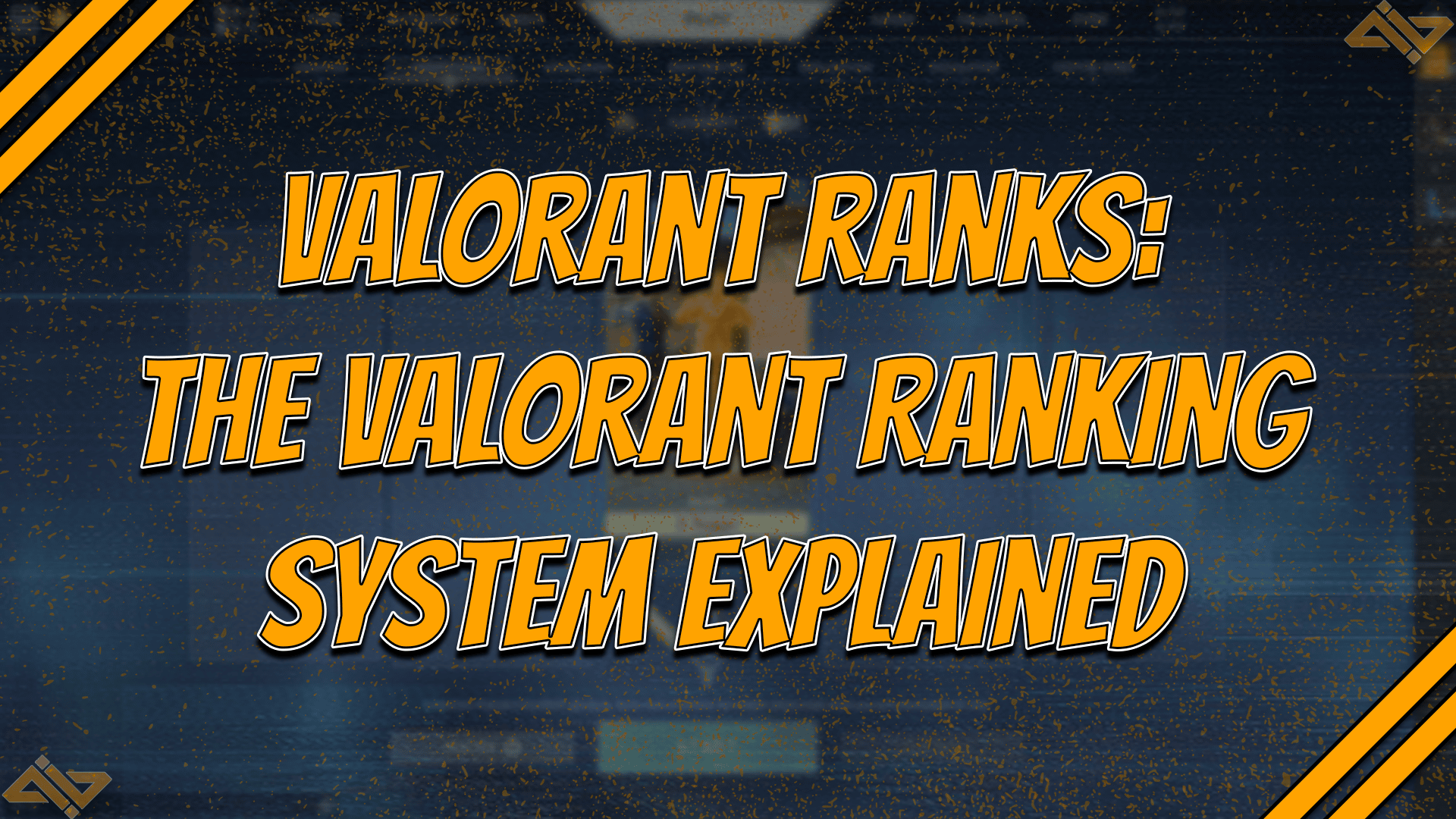Once you’re done playing the standard Unrated queue, and you’ve already gotten a good grasp of the different Valorant agents. The next step is finally queueing for a Competitive game and earning your first Valorant rank.
Climbing the Valorant ranks is one of the most satisfying things. Playing Competitive queue is one of the best things you can do to improve, aside from aim training. Competitive queue exposes you to people with the same skill level, allowing you to learn and adapt.
Don’t be intimidated to start your first Valorant ranked game. Here’s the complete Valorant ranking system explained.
Valorant Ranks Explained

First of all, Valorant matches you with other players that have a similar skill level to you. They do this through a hidden match making rating (MMR) system, which is a standard practice across most online games.
Your MMR basically puts you on a huge ladder that covers all Valorant players. Wins can help you move up within the ladder, and losses will result in you moving down. This is different from the actual rank and rank rating you can see in the game.
Once you queue up for a game, Valorant will try to find other players who are also looking for a match within the same MMR range. This allows for a fair and relatively balanced game that everyone can enjoy.
Other factors affecting your MMR include your combat score, the number of rounds you win, and the ranks or MMRs of the players you defeat. The combat score is calculated through the number of kills, the damage you do, and the non-damaging assists you contribute. This is why it’s always important to remember healing, smoking, and setting up your allies.
Those were the basic things that you need to know about your MMR and the Valorant ranking system.
All Valorant Ranks

There are currently 9 different Valorant rank divisions. Each rank is then divided into three tiers, all with the same naming scheme. Iron is composed of Iron 1, Iron 2, Iron 3, Silver is composed of Silver 1, Silver 2, Silver 3, and so on.
Radiant is the only rank that doesn’t have three tiers. The Radiant rank is only reserved for the top 500 players within each region.
Generally speaking, your rank will give you a general idea of your skill at the game. Iron – Silver ranks are usually players who are still getting used to the game and learning the mechanics. Gold – Diamond players usually understand the game but need to develop better mechanics or vice versa.
High Diamond and Ascendant players have a good feel for the game and understand it well. Sometimes they just need to develop certain aspects of their game to hit the next level.
Finally, Immortal and Radiant players are among the best in the region. Generally, they know the ins and outs of the game with excellent fundamentals and mechanical skills. Most players within these ranks are typically Valorant streamers or professional players.
Unlocking Competitive Queue
When you create a new Valorant account, you’ll probably notice that the Competitive queue, aka ranked queue, isn’t available to you yet. You’ll have to reach account level 20 first to unlock the Competitive game mode.
This mechanic is implemented to help prevent smurfs and cheaters from creating multiple accounts. This also ensures that new players are properly introduced to the game and get a good grasp of the different agents and maps before playing ranked.
Getting level 20 should be relatively easy. All you have to do is play some Unrated games and try to finish the weekly and daily missions for some extra XP. I’m sure you’ll get it in no time.
Placement Games

You’ll need to play a total of five placement games to unlock your rank. These games will be used by the Valorant ranking system to properly determine where you should be placed on the MMR ladder.
Your account’s MMR and Valorant rank will be determined by how well you perform within these placement games. Riot is already taking some notes from your previous Unrated games to determine a temporary MMR before you play some ranked. So make sure to take those first Unrated games seriously if you want to get a good starting rank.
Try your hardest to win these first five placement games since each win will greatly boost your MMR and, in turn, give you a higher rank.
Don’t worry if you end up losing a game or two. Your MMR can still be positively affected by losses, especially if you play very well for that skill level.
If you want to get a good idea of what rank you’ll end up in after your placement games, you can take a look at the ranks of the players within your matches. You’ll be matched with similarly skilled players, giving you a general idea of your appropriate rank.
How to Rank Up in Valorant?
Valorant makes use of a rank rating system to let you know when you’ll rank up or down. The system is pretty straightforward. Each rank is composed of 100 RR; you’ll need to get at least 100 RR to rank up. Once you get past 100 RR, you should automatically rank up, and you’ll start with at least 10 RR the following rank.
On the other hand, you can also get demoted. Once you reach 0 RR, you’ll need to win your next game, or else you’ll get demoted to the rank below yours.
You can only gain, retain, or lose RR. Each win will help you gain a certain amount of RR, depending on your MMR and the lobby’s MMR. Generally, you can expect somewhere around an 18-22 RR gain for every win.
There’s only one way to earn a +0 RR after a match: during draws. When a game ends in a tie, you can only retain your current RR (+0) or slightly increase it (+1 or +2); you can never lose RR.
Finally, you lose RR with every defeat. Generally, you’ll see a lower decrease during losses and higher gains during wins. This means that you have a good MMR for your rank. You can expect a 15-18 RR reduction for every loss.
Match Making Rating (MMR) vs. Rank Rating (RR)

While MMR and RR both relate to your rank in Valorant, these are actually two different things. Most people interchange the two, even though they affect your rank differently. Here are the differences between match making rating (MMR) and rank rating (RR).
Your rank rating (RR) is the visible points and bar that you see under your rank in your match history. This is an indicator you can use to tell you when you’ll rank up or when you’ll get demoted.
On the other hand, your match making rating (MMR) is a measurement of your general skill level when compared to all other players. Your MMR determines the players you’ll get matched against when you queue for a game in Valorant. It’s also used to determine what rank you belong to.
You can gain or lose RR after each game of Valorant. For wins, you can gain anywhere from 10 RR all the way up to 50 RR. For losses, you can decrease anywhere between 10 RR and 30 RR. The RR you gain or lose depends on your current MMR with respect to the lobby’s average MMR and how well you played against these players.
Overall, your RR gains and losses are affected by your MMR, but MMR isn’t affected by your RR.
What Factors Can Affect your MMR and RR?
If you’re playing against people with a higher rank, you perform well in the game, get match MVP, and win, you’ll gain higher MMR and RR.
However, if you’re playing against lower ranks and end up losing, you’ll see a higher RR reduction, and it will also negatively impact your MMR.
Factors like the number of rounds you win, your combat score, and overall performance also contribute to your MMR and RR. There aren’t any numbers or formulas for specific gains or losses, so it’s hard to pinpoint exactly what you need to do.
The important thing to remember is that this isn’t a quick process, and it takes place over multiple games. Every win and loss matters, but you aren’t going to have Diamond MMR today and then suddenly Silver MMR tomorrow. Just be patient and let your skills take you to that next rank.
What is Act Rank?

Once you’ve gotten used to the intricacies of Valorant ranks, you can start building towards your Act Rank. Your Act Rank is a triangle that is made up of all your wins in Competitive within a specific Valorant Act. At the top, you’ll see the highest rank you’ve won a game in, and as you go down the pyramid, you’ll see the other games you’ve won.
There are also various Act Rank borders that you can unlock via the number of wins that you get. You can unlock the maximum border level 5 by getting at least 100 ranked wins for a given Act. These borders are quite flashy and are shown together with your previous act rank during the loading screen.
Besides showing off, the Act Rank is mostly a way to monitor your progress. Even though it doesn’t show any specific Valorant stats, it’s still a great way to keep track of your journey.
Rank Resets and Rank Decay
Most online games with ranks implement a feature called “rank decay.” Most PvP games should have rank decay in some shape or form. This means that if you don’t play these games for a long time, your rank will slowly go down to a certain extent.
However, Valorant isn’t like most online games. There is no Valorant rank decay. If you leave the game at Gold 2 and come back after a month, you’ll still be in Gold 2 without any penalties or consequences.
One thing that Valorant does have over other games is frequent rank resets. These are done at the end of Acts and Episodes, where you’ll be assigned a temporary “Unranked” status. To get back your rank, you’ll have to play a certain amount of Competitive games within the new Act or Episode.
At the end of each Act, Riot does a “soft reset” of your rank. They give you the Unranked status, and you’ll have to play a game to regain your previous rank. The rank you ended an Act with will still be the same rank you get once you finish your “placement” game for the new Act.
At the end of each Episode, instead of a soft reset, Riot does a “hard reset” of everyones’ rank. You’ll have to play 5 placement games this time, and your rank will be adjusted accordingly. This gives everyone a fresh start and a chance to climb the ranks once again. Generally, you can expect around a 1 or 2 rank difference from the rank you ended with in the last Episode.
Who Can You Play With?

Usually, you can’t play with people with way higher or lower ranks than yours. This limitation is put in place in most online games and helps prevent incredibly unbalanced matches and boosting accounts.
Once you reach Gold and above, you can queue up with players with ranks one tier above or below you. For Platinum players, you can team up with any Gold player or any Diamond player, but not at the same time.
From Iron up to Silver, you can pretty much queue up without any problems. Iron players can team up with Bronze or Silver, and vice versa. However, Silvers can also play with Golds but not at the same time as Bronze or Iron.
All of the above rules apply to parties of 3 players or less. So if the skill disparity is way too high, you’ll have to switch accounts to meet the rank requirements or play individually.
However, you can also form a pre-made group of 5. You can queue with players with a higher skill disparity, but you’ll all gain less RR. This was done to help combat smurfs while not completely destroying the Valorant rank distribution. This also allows high-ranked players to enjoy the company of their lower-ranked friends and still play the game together.
Expect to have longer queue times, though, since you’ll only be matched with another five stack with a similar MMR. This ensures that the game’s competitive integrity is still in place and remains fair for both sides. You can expect around a 25% up to 90% RR reduction, depending on how large the skill disparity is in your group.
The only thing you can’t do is to four-stack. Valorant made this change to avoid any toxic behavior towards the final individual player that you will be matched with.
Conclusion
That’s the complete breakdown of the Valorant ranks and the Valorant ranking system. Hopefully, you were able to fully understand how Valorant ranks work and can finally climb to that coveted rank you want.
What Valorant rank are you aiming for? Leave a comment down below.










